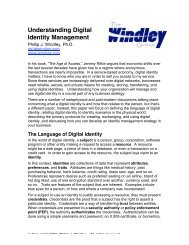Digital ID and eGovernment - Phil Windley's Technometria
Digital ID and eGovernment - Phil Windley's Technometria
Digital ID and eGovernment - Phil Windley's Technometria
- No tags were found...
You also want an ePaper? Increase the reach of your titles
YUMPU automatically turns print PDFs into web optimized ePapers that Google loves.
<strong>Digital</strong> <strong>ID</strong> <strong>and</strong> <strong>eGovernment</strong><strong>Phil</strong>lip J. Windley, Ph.D.phil@windley.orghttp://www.windley.comGovernments are vitally concerned with identity <strong>and</strong> yet, paradoxically, mostgovernments have been largely unwilling to take a leadership role in the digitalidentity arena.As commonly used, the term “digital identity” refers to a set of properties about anindividual that are associated together <strong>and</strong> available in electronic form. Identities,digital or otherwise, are assumed to be unique. Normally when we talk aboutidentity, we think of people, but that need not be the case. For example, vehicleshave unique identities <strong>and</strong> states go to great lengths to establish <strong>and</strong> secure thoseidentities in the form of vehicle titles.When most entities talk about “digital identity” they are more concerned with theproperties that the identity has than they are with tying that identity to a specificperson. For example, Amazon.com is happy if the identity presented has twospecific properties: a valid credit card number with a balanced in the credit limit<strong>and</strong> a valid address for delivery. The credit card company just cares that the billgets paid regularly. Even the post office only cares about locations, not the peopleat those locations.This is not the case with Government. In almost every case, Government caresdeeply that the identity is tied to a specific person. Sometimes this is because thatidentity is associated with an authorization for that person to perform certainactions in the physical world, like drive a car or practice medicine. In other cases,its because the identity might be used to do something as severe as put take awaythe person’s freedom or even put them to death.The Driver’s License as IdentityThe driver’s license represents the one of the clearest examples in the physicalworld of the three functions we associate with identification. In one simpledocument that you can carry around in your wallet, it supplies:• Identity – the driver’s license lists a number of properties about a personthat identify that individual, including name, address, <strong>and</strong> so on.• Authentication – most driver’s licenses carry a simple biometric called apicture which can be used by almost anyone to authenticate the licenseagainst the individual presenting it.• Authorization – the primary purpose of the driver’s license is to indicatewhat vehicles the government has authorized the individual to legallyoperate, <strong>and</strong> under what conditions.In the United States, the state issued driver’s license is, for better or worse, thegold st<strong>and</strong>ard for identity. Every other form of <strong>ID</strong> is an afterthought. You can use
something else to get on a plane or verify your identity when you cash a check, buthardly anyone does.States didn’t set out to create an identity instrument when they created driver’slicenses. They were doing exactly what the instrument is called: licensing drivers.But once it had been created it filled a need beyond what it was designed for <strong>and</strong>was quickly co-opted to a new role: establishing identity. Even now, if you ask thehead of your state’s driver’s license bureau about the driver’s license as an identityinstrument, they’re likely to deny that it has any such purpose.There are no st<strong>and</strong>ards for driver’s licenses <strong>and</strong> they vary widely across the 50states in what information they convey; some states don’t even require a picture.Furthermore, as a rule, states have put more information on the driver’s licensethan what is required to establish an authorization to drive. For example, onecould argue that if the sole purpose of the driver’s license were merely indicatingauthorization to drive, the address of the person is irrelevant. In fact, their name isprobably irrelevant as well in that case. In truth, the use of the driver’s licensegoes well beyond driving authorization, including information about blood type <strong>and</strong>even whether or not the carrier wishes to be an organ donor.Governments <strong>and</strong> IdentityGovernments are vitally concerned with identity. I would argue that identity is afoundational piece of almost everything a government does. Here are someexamples of governmental activities that affect or make use of identity.Vital Records. Governments took over the function of keeping vital recordssporadically during the 19 th century---mostly for public health reasons. Therecords that are most applicable to identity are the birth <strong>and</strong> death certificates. Insome states, simply possessing a birth certificate is enough to establish identity forthe purpose of gaining a driver’s license.Permitting. Governments spend most of their time authorizing someone to dosomething or prohibiting someone from doing something. To be effective, theyhave to know who they are authorizing or prohibiting.Contracts. Governments have a responsibility for building a set of laws underwhich commerce can flourish <strong>and</strong> people can live their lives. Inherent in thisresponsibility is the need to identify the parties to contracts <strong>and</strong> other agreements.Public Safety <strong>and</strong> Criminal Justice. Governments obviously play a large role inpublic safety <strong>and</strong> are the only game in town in the area of criminal justice. Identityis a big part of that. In fact, one could argue that the sole purpose of a trial,establishing guilt or innocence, is largely an identity problem. The police gather aset of properties that are connected with the crime <strong>and</strong> then the prosecutor tries toprove that the suspect on trial has those properties. Once we have verified theidentity of the suspect as the one who actually committed the crime, we lock themaway.Passports. The federal government issues passports to US citizens to verifycitizenship. In general function, it is very much like a driver’s license. It listsidentifying traits <strong>and</strong> properties, includes a picture for authentication purposes, <strong>and</strong>authorizes the rights of citizenship to any authenticated possessor.
The Proper Role of Government in <strong>Digital</strong> IdentityI think its fascinating that even though governments depend on identity as a corecomponent of their activities, governments in the US have, almost universally,failed to take an active role in developing the means to identify citizens in thedigital world.While I believe that governments have a vital <strong>and</strong> proper role to play in establishing<strong>and</strong> issuing foundational identity documents, I believe that their role ends there. Ido not believe that governments need to be in the business of creating directoriesor other infrastructures used in the processing or validation of identity other thanfor their own use.As part of their duties in establishing the foundation or digital identity, I think stateshave three key artifacts that they should address: vital records, driver’s license,<strong>and</strong> digital certificates.Vital RecordsAs I mentioned before, one of the roles that states play in the area of identity in thephysical world is in keeping vital records. States keep vital records in databases,but when you want a copy for your use, they print you out a certified paper copy ofthe electronic record. At this point, I know of no state that issues birth <strong>and</strong> deathcertificates as digital documents. In some states you can view an image of thedocument on the Internet, but it is not a certified copy that can be used for anypurpose other than information. One ought to be able to file a life insurance claimonline, for example, using a digital copy of the death certificate <strong>and</strong> a digitalsignature.States should be checking that a birth certificate exists for each driver’s licensethey issue, that only one driver’s license has been issued for that birth certificate,<strong>and</strong> that no corresponding death certificate exists. This is made more difficult bythe fact that vital records are stored in each of the fifty states separately <strong>and</strong> insome states not even stored at the state level but in counties instead. So, whensomeone applies for a driver’s license in one state, the system would need accessto the vital records in all fifty states to make a proper check. What is needed is anational clearinghouse for the information. EVital is a Federal program that will linkstate vital records to the Social Security Administration for the purpose ofexpediting the issuing of social security numbers <strong>and</strong> benefits. With such a systemin place, using it to validate <strong>and</strong> verify vital records for other purposes, such asestablishing identity, would be a natural evolution.Driver’s LicenseStates need to recognize that the driver’s license is an identity card <strong>and</strong> starttreating it like one. We could more properly refer to this as a state <strong>ID</strong> card, but themoniker “driver’s license” has stuck, so we might as well keep using it. Further, thedriver’s license ought to be based on smart card technology <strong>and</strong> contain identifyinginformation in some st<strong>and</strong>ard format that can be used in a variety of situations toform the basis of identity. One could present their driver’s license in an online
transaction the same way that one presents it in the physical world. Of course,some means of authentication besides the picture would need to be used.I believe that homel<strong>and</strong> security is going to be a driving force in the use of thedriver’s license as a national identity document. The federal government isunlikely, for political reasons, to begin a national <strong>ID</strong> card program, but they couldforce states to use common st<strong>and</strong>ards, including smart cards, that would create ade facto national <strong>ID</strong> card system. For such a system to be useful for thingsbesides homel<strong>and</strong> security, a broad range of technologists will have to be involvedin its creation.<strong>Digital</strong> CertificatesNo paper on digital <strong>ID</strong> <strong>and</strong> <strong>eGovernment</strong> would be complete without a look atdigital certificates. Governments turned to digital certificates <strong>and</strong> their associateddigital signatures early on as a way to solve the digital <strong>ID</strong> dilemma. In truth, digitalsignatures have largely failed to deliver on their promise <strong>and</strong> most have stoppedlooking to them as a replacement for physical signatures. I think thatGovernment’s inability to clearly see its role in providing the foundational structurein digital identity is a significant contributing cause for this failure.Instead of recognizing the key role that they play in establishing identity in thephysical world <strong>and</strong> then seeking to play a similar role in the digital world,governments turned to commercial entities to create, authenticate, <strong>and</strong> sell digitalcertificates (i.e. act as certificate authorities).I argue that issuing digital certificates is a proper role of Government given th<strong>eGovernment</strong>’s obvious interest in identity <strong>and</strong> its de facto role in identity by issuingdriver’s licenses, passports, <strong>and</strong> other identity documents. Even so, no stategovernment has taken on the role of certificate authority. There are a few who areissuing digital certificates to their citizens, but they use a commercial certificateauthority to do so.I believe that this has been one of the primary causes for the spotty use of digitalcertificates in electronic government <strong>and</strong> commercial transactions. They areprohibitively expensive in many cases. This expense helps mitigate the risk thatcertificate authorities assume for misidentifying someone. Governments can (<strong>and</strong>frequently do) indemnify themselves against such risk <strong>and</strong> could issue digitalcertificates that are at least as trustworthy as the state issued driver’s license at avery low cost. In fact, such certificates could be routinely issued as part of theprocess of issuing a driver’s license if the license was based on smart cardtechnology.ConclusionGovernments have long played a role in identity in the physical world, but haveabdicated their responsibility in this area for digital identity. In the US we have ahealthy skepticism of government identity programs, which is one of the hurdlesgovernment involvement in digital identity will have to overcome. Even so, imaginewhat commerce in the physical world would look like if no driver’s license existed<strong>and</strong> states had never assumed responsibility for vital records. Certainly commerce
would have not come to a st<strong>and</strong>still, something would have filled the vacuum, butthe look of commerce would be very different. Governments have a responsibilityto establish societal scaffolding in support of commerce. I contend that thedissonance that we experience by having government serve as the foundation foridentity in the physical world, but not in the digital world is partly responsible formany of the problems we face in using digital identity <strong>and</strong> a significant source offriction in electronic transactions. Serving as the foundation for identity is a properrole for government <strong>and</strong> we should work to bring it about in the digital world.About the Author<strong>Phil</strong>lip J. Windley is a nationally recognized expert in using information technology(IT) to add value to the business. Dr. Windley regularly consults with businesseson this topic. He is particularly interested in the areas of interoperability, webservices, XML, <strong>and</strong> digital identity. Dr. Windley is a frequent author <strong>and</strong> speaker onthese topics <strong>and</strong> authors a free, daily web-based newsletter at www.windley.com.His web-site contains numerous white papers in these areas <strong>and</strong> others.Dr. Windley served from 2001-2002 as the Chief Information Officer (CIO) for theState of Utah serving on the Governor's Cabinet <strong>and</strong> as a member of his SeniorStaff. In this capacity he was responsible for effective use of all IT resources in thestate <strong>and</strong> advised the Governor on technology issues. During his tenure, the Statewas repeatedly recognized by many national groups for its excellence in the areasof IT <strong>and</strong> <strong>eGovernment</strong>.Prior to his appointment as CIO, Dr. Windley served as Vice President for ProductDevelopment <strong>and</strong> Operations at Excite@Home, managing a large, interdisciplinaryteam of product managers, engineers, <strong>and</strong> technicians developing <strong>and</strong> operatinglarge scale Internet <strong>and</strong> e-commerce products. Prior to joining Excite@Home, Dr.Windley served for two years as Chief Technology Officer (CTO) of iMALL, Inc. anearly leader in electronic commerce. Dr. Windley has been a professor ofComputer Science at Brigham Young University <strong>and</strong> the University of Idaho. AtBYU he founded <strong>and</strong> directed the Laboratory for Applied Logic. Windley receivedhis PhD in Computer Science from the University of California, Davis in 1990.Prior to doing graduate studies, Windley worked for 4 years as a nuclearmetallurgist <strong>and</strong> a member of the technical staff at the Department of Energy'sDivision of Naval Reactors.Copyright Information” Copyright 2003, <strong>Phil</strong>lip J. Windley. All rights reserved. Reproduction of all orpart of this work is permitted for educational or research use provided that thiscopyright notice is included in any copy. This document is available online athttp://www.windley.com/.






